Accounting Differences: Proprietorship vs. Partnership in Australia
VerifiedAdded on 2023/04/12
|5
|847
|135
Report
AI Summary
This report provides a comparative analysis of proprietorship companies and partnership firms in Australia, addressing their structural, operational, and financial aspects. It examines the key differences in formation, profit sharing, liability, and membership, highlighting the advantages and disadvantages of each business structure. The report further delves into the requirements for listing a company on the Australian Stock Exchange (ASX), including listing criteria, advantages, disadvantages, and various funding sources such as debt and equity. It also outlines the reporting requirements for ASX-listed companies, including board meetings, annual general meetings, and committee structures. References to relevant literature support the analysis, providing a comprehensive overview of the financial accounting considerations for different business structures in the Australian context.
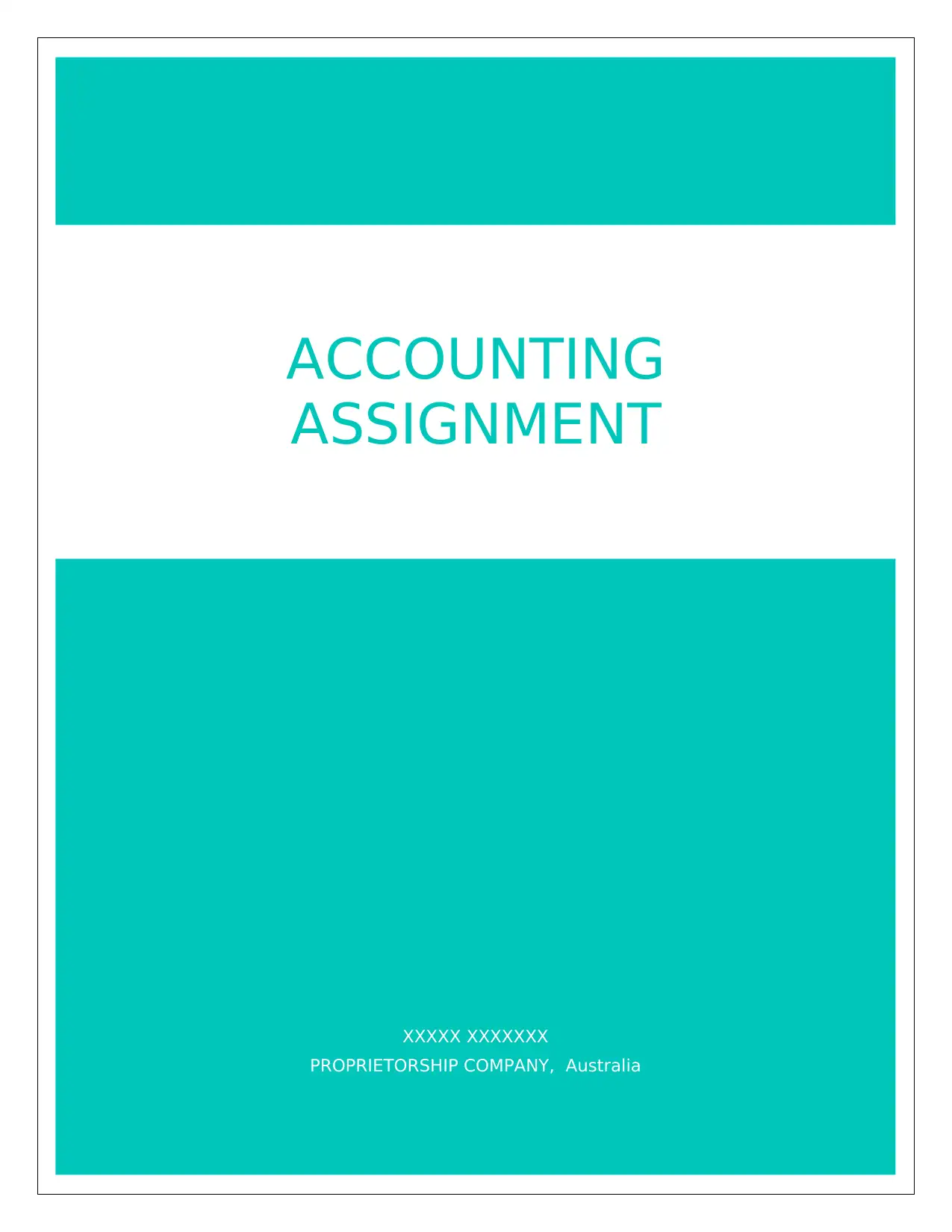
XXXXX XXXXXXX
PROPRIETORSHIP COMPANY, Australia
ACCOUNTING
ASSIGNMENT
PROPRIETORSHIP COMPANY, Australia
ACCOUNTING
ASSIGNMENT
Paraphrase This Document
Need a fresh take? Get an instant paraphrase of this document with our AI Paraphraser
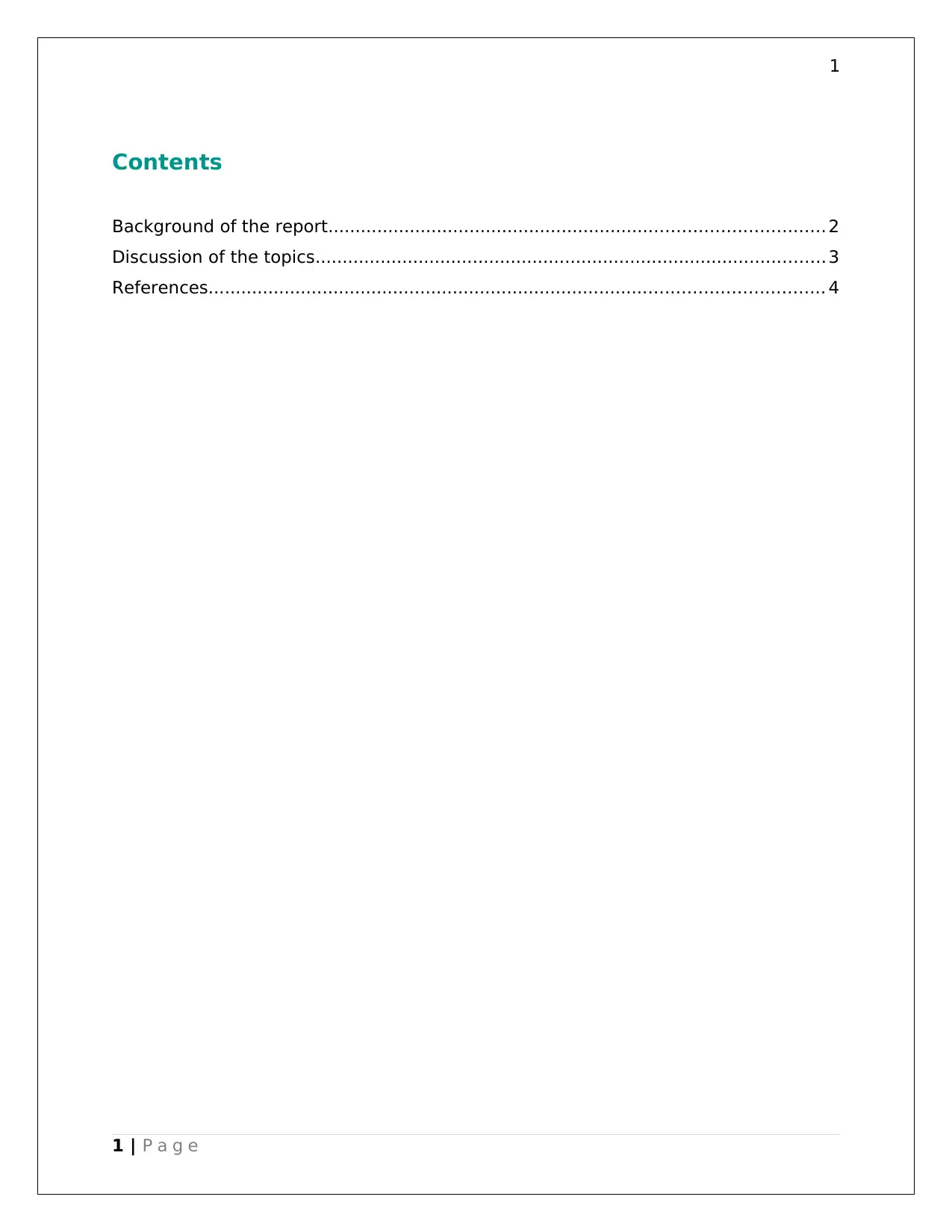
1
Contents
Background of the report........................................................................................... 2
Discussion of the topics.............................................................................................. 3
References................................................................................................................. 4
1 | P a g e
Contents
Background of the report........................................................................................... 2
Discussion of the topics.............................................................................................. 3
References................................................................................................................. 4
1 | P a g e
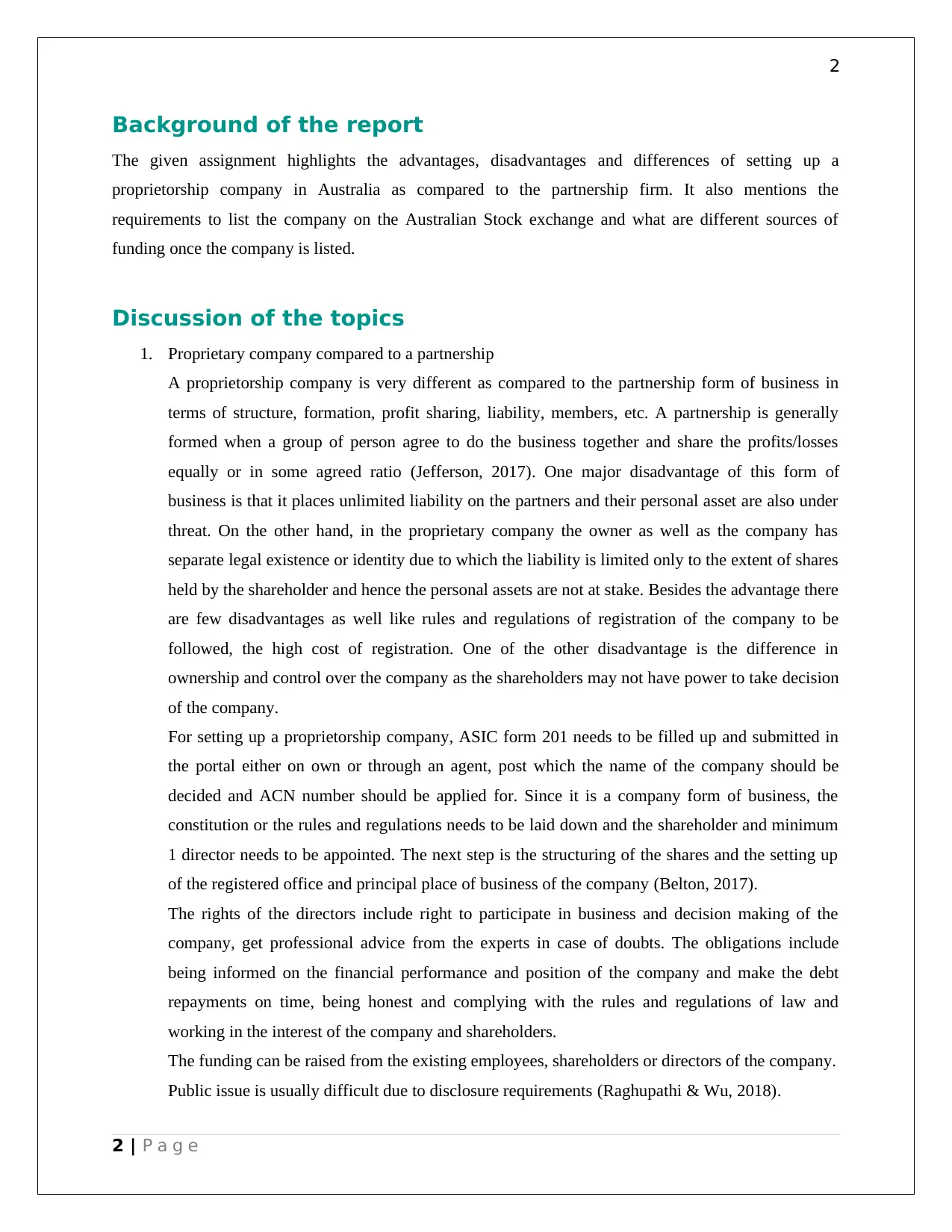
2
Background of the report
The given assignment highlights the advantages, disadvantages and differences of setting up a
proprietorship company in Australia as compared to the partnership firm. It also mentions the
requirements to list the company on the Australian Stock exchange and what are different sources of
funding once the company is listed.
Discussion of the topics
1. Proprietary company compared to a partnership
A proprietorship company is very different as compared to the partnership form of business in
terms of structure, formation, profit sharing, liability, members, etc. A partnership is generally
formed when a group of person agree to do the business together and share the profits/losses
equally or in some agreed ratio (Jefferson, 2017). One major disadvantage of this form of
business is that it places unlimited liability on the partners and their personal asset are also under
threat. On the other hand, in the proprietary company the owner as well as the company has
separate legal existence or identity due to which the liability is limited only to the extent of shares
held by the shareholder and hence the personal assets are not at stake. Besides the advantage there
are few disadvantages as well like rules and regulations of registration of the company to be
followed, the high cost of registration. One of the other disadvantage is the difference in
ownership and control over the company as the shareholders may not have power to take decision
of the company.
For setting up a proprietorship company, ASIC form 201 needs to be filled up and submitted in
the portal either on own or through an agent, post which the name of the company should be
decided and ACN number should be applied for. Since it is a company form of business, the
constitution or the rules and regulations needs to be laid down and the shareholder and minimum
1 director needs to be appointed. The next step is the structuring of the shares and the setting up
of the registered office and principal place of business of the company (Belton, 2017).
The rights of the directors include right to participate in business and decision making of the
company, get professional advice from the experts in case of doubts. The obligations include
being informed on the financial performance and position of the company and make the debt
repayments on time, being honest and complying with the rules and regulations of law and
working in the interest of the company and shareholders.
The funding can be raised from the existing employees, shareholders or directors of the company.
Public issue is usually difficult due to disclosure requirements (Raghupathi & Wu, 2018).
2 | P a g e
Background of the report
The given assignment highlights the advantages, disadvantages and differences of setting up a
proprietorship company in Australia as compared to the partnership firm. It also mentions the
requirements to list the company on the Australian Stock exchange and what are different sources of
funding once the company is listed.
Discussion of the topics
1. Proprietary company compared to a partnership
A proprietorship company is very different as compared to the partnership form of business in
terms of structure, formation, profit sharing, liability, members, etc. A partnership is generally
formed when a group of person agree to do the business together and share the profits/losses
equally or in some agreed ratio (Jefferson, 2017). One major disadvantage of this form of
business is that it places unlimited liability on the partners and their personal asset are also under
threat. On the other hand, in the proprietary company the owner as well as the company has
separate legal existence or identity due to which the liability is limited only to the extent of shares
held by the shareholder and hence the personal assets are not at stake. Besides the advantage there
are few disadvantages as well like rules and regulations of registration of the company to be
followed, the high cost of registration. One of the other disadvantage is the difference in
ownership and control over the company as the shareholders may not have power to take decision
of the company.
For setting up a proprietorship company, ASIC form 201 needs to be filled up and submitted in
the portal either on own or through an agent, post which the name of the company should be
decided and ACN number should be applied for. Since it is a company form of business, the
constitution or the rules and regulations needs to be laid down and the shareholder and minimum
1 director needs to be appointed. The next step is the structuring of the shares and the setting up
of the registered office and principal place of business of the company (Belton, 2017).
The rights of the directors include right to participate in business and decision making of the
company, get professional advice from the experts in case of doubts. The obligations include
being informed on the financial performance and position of the company and make the debt
repayments on time, being honest and complying with the rules and regulations of law and
working in the interest of the company and shareholders.
The funding can be raised from the existing employees, shareholders or directors of the company.
Public issue is usually difficult due to disclosure requirements (Raghupathi & Wu, 2018).
2 | P a g e
⊘ This is a preview!⊘
Do you want full access?
Subscribe today to unlock all pages.

Trusted by 1+ million students worldwide
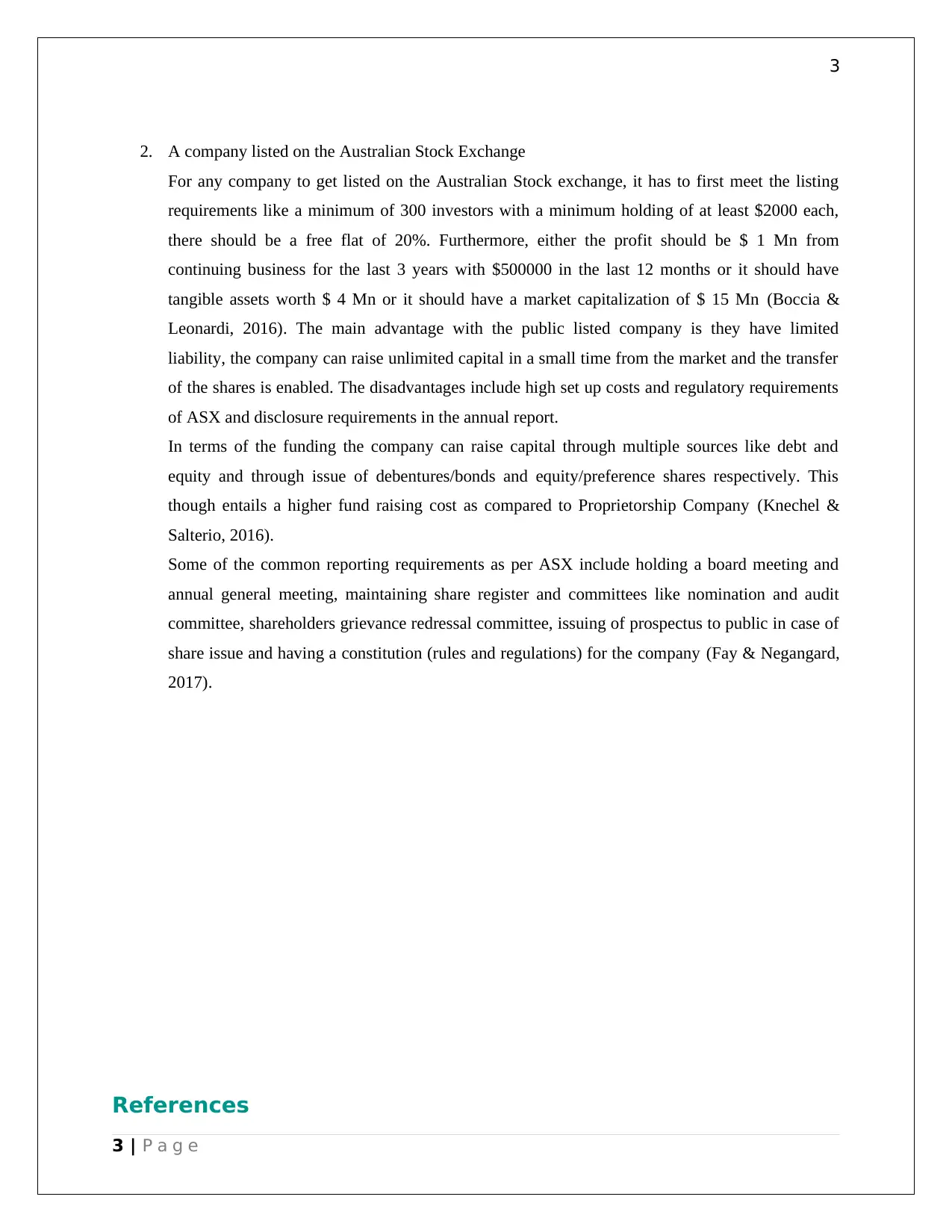
3
2. A company listed on the Australian Stock Exchange
For any company to get listed on the Australian Stock exchange, it has to first meet the listing
requirements like a minimum of 300 investors with a minimum holding of at least $2000 each,
there should be a free flat of 20%. Furthermore, either the profit should be $ 1 Mn from
continuing business for the last 3 years with $500000 in the last 12 months or it should have
tangible assets worth $ 4 Mn or it should have a market capitalization of $ 15 Mn (Boccia &
Leonardi, 2016). The main advantage with the public listed company is they have limited
liability, the company can raise unlimited capital in a small time from the market and the transfer
of the shares is enabled. The disadvantages include high set up costs and regulatory requirements
of ASX and disclosure requirements in the annual report.
In terms of the funding the company can raise capital through multiple sources like debt and
equity and through issue of debentures/bonds and equity/preference shares respectively. This
though entails a higher fund raising cost as compared to Proprietorship Company (Knechel &
Salterio, 2016).
Some of the common reporting requirements as per ASX include holding a board meeting and
annual general meeting, maintaining share register and committees like nomination and audit
committee, shareholders grievance redressal committee, issuing of prospectus to public in case of
share issue and having a constitution (rules and regulations) for the company (Fay & Negangard,
2017).
References
3 | P a g e
2. A company listed on the Australian Stock Exchange
For any company to get listed on the Australian Stock exchange, it has to first meet the listing
requirements like a minimum of 300 investors with a minimum holding of at least $2000 each,
there should be a free flat of 20%. Furthermore, either the profit should be $ 1 Mn from
continuing business for the last 3 years with $500000 in the last 12 months or it should have
tangible assets worth $ 4 Mn or it should have a market capitalization of $ 15 Mn (Boccia &
Leonardi, 2016). The main advantage with the public listed company is they have limited
liability, the company can raise unlimited capital in a small time from the market and the transfer
of the shares is enabled. The disadvantages include high set up costs and regulatory requirements
of ASX and disclosure requirements in the annual report.
In terms of the funding the company can raise capital through multiple sources like debt and
equity and through issue of debentures/bonds and equity/preference shares respectively. This
though entails a higher fund raising cost as compared to Proprietorship Company (Knechel &
Salterio, 2016).
Some of the common reporting requirements as per ASX include holding a board meeting and
annual general meeting, maintaining share register and committees like nomination and audit
committee, shareholders grievance redressal committee, issuing of prospectus to public in case of
share issue and having a constitution (rules and regulations) for the company (Fay & Negangard,
2017).
References
3 | P a g e
Paraphrase This Document
Need a fresh take? Get an instant paraphrase of this document with our AI Paraphraser
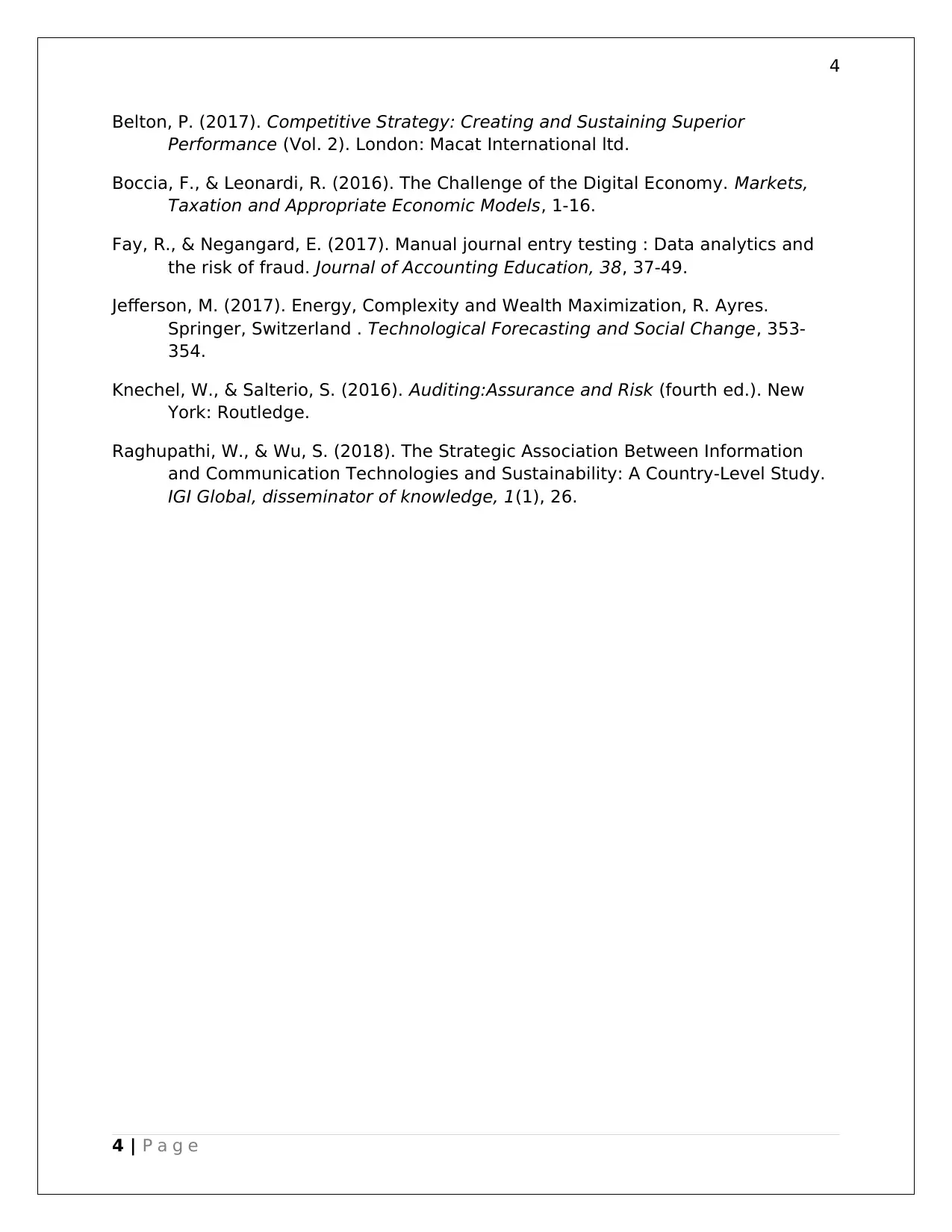
4
Belton, P. (2017). Competitive Strategy: Creating and Sustaining Superior
Performance (Vol. 2). London: Macat International ltd.
Boccia, F., & Leonardi, R. (2016). The Challenge of the Digital Economy. Markets,
Taxation and Appropriate Economic Models, 1-16.
Fay, R., & Negangard, E. (2017). Manual journal entry testing : Data analytics and
the risk of fraud. Journal of Accounting Education, 38, 37-49.
Jefferson, M. (2017). Energy, Complexity and Wealth Maximization, R. Ayres.
Springer, Switzerland . Technological Forecasting and Social Change, 353-
354.
Knechel, W., & Salterio, S. (2016). Auditing:Assurance and Risk (fourth ed.). New
York: Routledge.
Raghupathi, W., & Wu, S. (2018). The Strategic Association Between Information
and Communication Technologies and Sustainability: A Country-Level Study.
IGI Global, disseminator of knowledge, 1(1), 26.
4 | P a g e
Belton, P. (2017). Competitive Strategy: Creating and Sustaining Superior
Performance (Vol. 2). London: Macat International ltd.
Boccia, F., & Leonardi, R. (2016). The Challenge of the Digital Economy. Markets,
Taxation and Appropriate Economic Models, 1-16.
Fay, R., & Negangard, E. (2017). Manual journal entry testing : Data analytics and
the risk of fraud. Journal of Accounting Education, 38, 37-49.
Jefferson, M. (2017). Energy, Complexity and Wealth Maximization, R. Ayres.
Springer, Switzerland . Technological Forecasting and Social Change, 353-
354.
Knechel, W., & Salterio, S. (2016). Auditing:Assurance and Risk (fourth ed.). New
York: Routledge.
Raghupathi, W., & Wu, S. (2018). The Strategic Association Between Information
and Communication Technologies and Sustainability: A Country-Level Study.
IGI Global, disseminator of knowledge, 1(1), 26.
4 | P a g e
1 out of 5
Related Documents
Your All-in-One AI-Powered Toolkit for Academic Success.
+13062052269
info@desklib.com
Available 24*7 on WhatsApp / Email
![[object Object]](/_next/static/media/star-bottom.7253800d.svg)
Unlock your academic potential
Copyright © 2020–2025 A2Z Services. All Rights Reserved. Developed and managed by ZUCOL.





